
Lenovo-owned Motorola has just come out with its new budget smartphone called the Moto G51. There are a few things instantly noteworthy on the device, such as the 120Hz LCD screen, a 50MP triple-camera, Dolby Atmos support, and more. However, I was intrigued by the Qualcomm Snapdragon 480+ SoC being employed for the device’s processing capabilities. For those who are not familiar with the American silicone maker’s nomenclature, the 400 series is usually reserved for budget smartphones. In the case of the 480+, Motorola has claimed that the performance threshold for the chip can be compared to the MediaTek Dimensity 700 or even the lower end 700 series like the Snapdragon 732G.
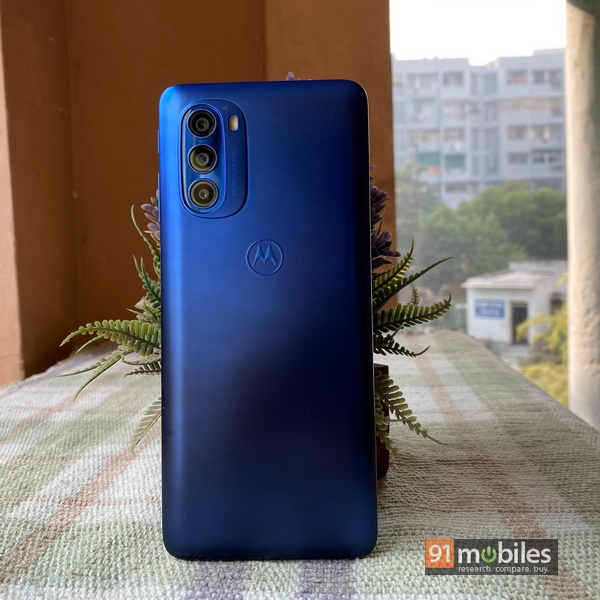
In this comparison let’s put the Moto G51 to the test against the POCO M3 Pro (review) which is running on the Dimensity 700. The parameters for the comparison will be based on both the devices’ Geekbench 5, Antutu V9.2.5, and 3DMark Wild Life scores. I will also see how both the chipsets handle sustained load in a 30 minute CPU throttle test. Lastly, both the devices come with a 5,000mAh battery and I will use PCMark’s Battery 3.0 test to determine how long each cell can last under a continuous workload.
Geekbench 5
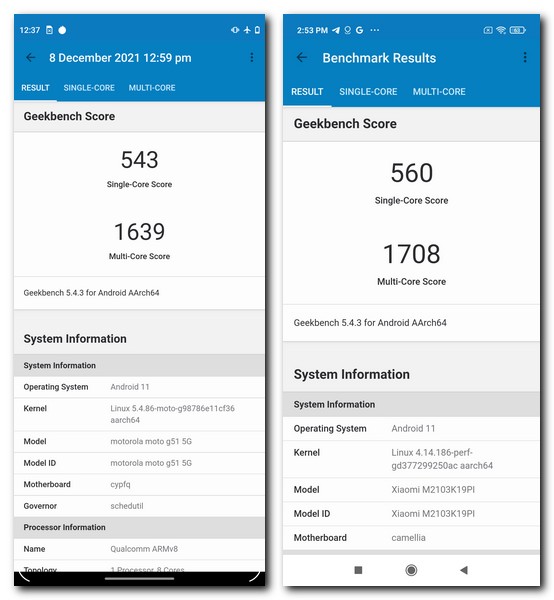
Let’s first start with the most common of benchmarks for CPU testing which is Geekbench 5. On the Moto G51, the single-core and multi-core scores are 543 and 1,639 respectively. On the POCO M3 Pro, those numbers are 560 and 1,708. You can see a marginal improvement in the latter but the difference in real-world performance would likely be negligible. The Snapdragon 480+ platform runs on two performance Kryo 460 Gold cores clocked at 2.2GHz and six efficiency Kryo 460 Silver cores spinning at 1.8GHz. On the Dimensity 700, the story is similar with two Cortex A76 performance cores at 2.2GHz but the six Cortex A55 cores spin slightly faster at 2.0GHz.
Antutu V9.2.5

Antutu is a good way to ascertain the phone’s overall performance including both the GPU and CPU. However, for some reason, the benchmark was not taking into consideration the GPU performance of either phone. As such the overall score for the Moto G51 happens to be 241,994 while for the POCO M3 Pro you see an overall score of 261,541. It is interesting to see a slightly higher CPU score on the Moto G51 while the POCO M3 Pro takes the lead in the memory and UI scores. Both phones lost about 2 percent battery while running the benchmark.
3DMark Wild Life
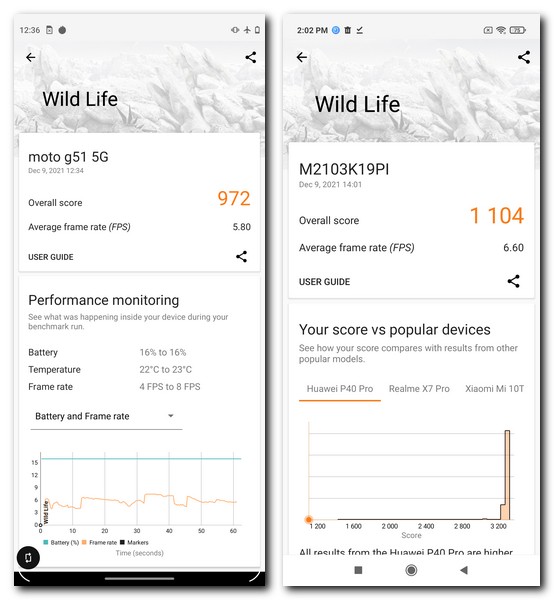
Since Antutu could not turn up with graphic metrics on both the devices, let’s turn towards the services of 3DMark’s Wild Life test. The synthetic benchmark runs a simulation on the device and returns an fps count. The Snapdragon 480+ makes use of the Adreno 619 GPU which has slightly higher compute strength as compared to the Mali-G57 MC2 although the latter does spin at a higher 950MHz. The Moto G51 gets an overall score of 972 while the POCO M3 Pro is slightly higher at 1,104.
CPU Throttle Test
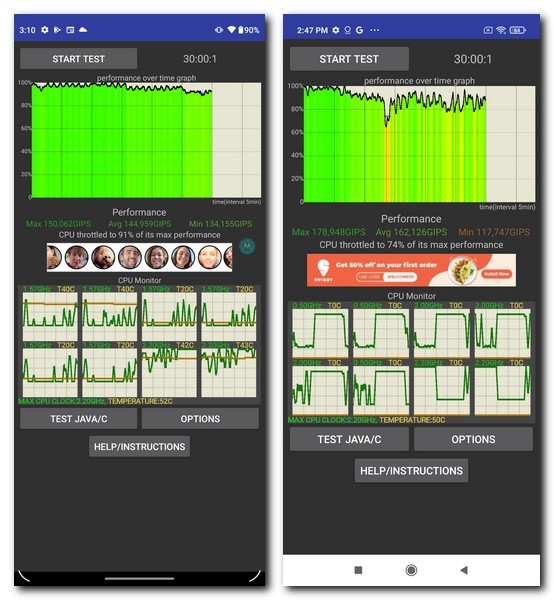
It is also important to know how good a smartphone’s performance is under sustained load. The CPU Throttle test stresses out the phone continuously for a period of 30 minutes. The results were interesting as the Moto G51 was able to maintain a minimum of 90 percent of its processing capabilities for the duration of this test. However, the POCO M3 Pro at one point dropped to nearly 60 percent and had a very erratic performance graph after that. The G51’s processor was running slightly hot at 52 degrees celsius as compared to 50 degrees on the POCO M3 Pro.
BGMI test
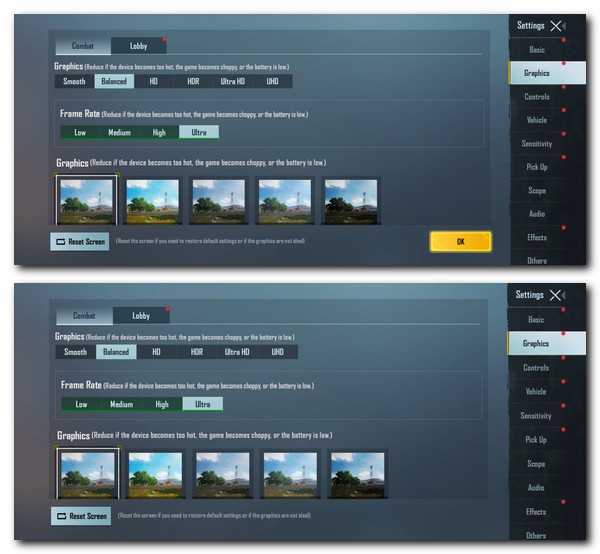
Battlegrounds Mobile India is likely one of the most challenging games for a smartphone to run, especially those in the budget category. The title is usually a good metric to test the GPU proficiency of a device. For this test, I’m going to play BGMI at the highest possible frame rate (FR) setting and match it with the best possible graphic quality that can go along with it. For the Moto G51 and the POCO M3 Pro, the FR settings are set to Ultra (45fps) and the graphics to Balanced. On these parameters, I took both the devices for a spin and gamed continuously for about 30 minutes. On the G51, battery levels dropped by 10 percent and the temperature rose by 6 degrees. The POCO M3 Pro for its part dropped 8 percent battery but was running quite hot with a temperature rise of 9 degrees.
PCMark Battery test and charging speeds
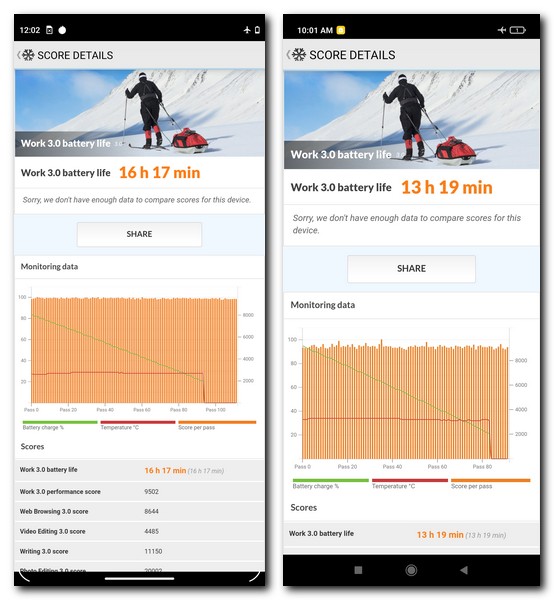
PCMark’s continuously looped daily workflow test returns a score that is a measure of time it takes to drop the battery from 100 percent to 20 percent. The Moto G51, with its 5,000mAh battery, gets a score of 16 hours and 17 minutes while the POCO M3 Pro, which also benefits from the same capacity battery, has a score of just 13 hours and 19 minutes.
In terms of charging speeds, the 20W charger on the Moto G51 can juice up the battery from 20 percent to 100 percent in 1 hour and 45 minutes. The POCO M3 Pro has a slightly slower 18W charging solution which takes about 2 hours.
Verdict
The Qualcomm Snapdragon 480+ powered G51 really does match up to the Dimensity 700 on the M3 Pro in almost all aspects. More importantly, the G51 manages to keep a good sustained performance whereas the POCO M3 Pro buckles up under load. In terms of graphical usage, both devices are equally adept at medium intensity gaming while on the battery front, the G51 does look superior. This is, of course, not the full review of the Moto G51. There is plenty that makes up for a good smartphone and the G51 does look, on paper, to be excelling in most of those.
The post Moto G51 vs POCO M3 Pro: performance and battery comparison first appeared on 91mobiles.com.
via ©91 Mobiles









No comments:
Post a Comment